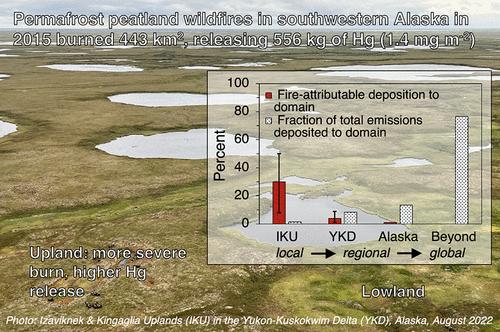当前位置:
X-MOL 学术
›
Environ. Sci. Technol.
›
论文详情
Our official English website, www.x-mol.net, welcomes your
feedback! (Note: you will need to create a separate account there.)
Substantial Mercury Releases and Local Deposition from Permafrost Peatland Wildfires in Southwestern Alaska
Environmental Science & Technology ( IF 10.8 ) Pub Date : 2024-11-11 , DOI: 10.1021/acs.est.4c08765 Scott Zolkos, Benjamin M. Geyman, Stefano Potter, Michael Moubarak, Brendan M. Rogers, Natalie Baillargeon, Sharmila Dey, Sarah M. Ludwig, Sierra Melton, Edauri Navarro-Pérez, Ann McElvein, Prentiss H. Balcom, Susan M. Natali, Seeta Sistla, Elsie M. Sunderland
Environmental Science & Technology ( IF 10.8 ) Pub Date : 2024-11-11 , DOI: 10.1021/acs.est.4c08765 Scott Zolkos, Benjamin M. Geyman, Stefano Potter, Michael Moubarak, Brendan M. Rogers, Natalie Baillargeon, Sharmila Dey, Sarah M. Ludwig, Sierra Melton, Edauri Navarro-Pérez, Ann McElvein, Prentiss H. Balcom, Susan M. Natali, Seeta Sistla, Elsie M. Sunderland

|
Increasing wildfire activity at high northern latitudes has the potential to mobilize large amounts of terrestrial mercury (Hg). However, understanding implications for Hg cycling and ecosystems is hindered by sparse research on peatland wildfire Hg emissions. In this study, we used measurements of soil organic carbon (SOC) and Hg, burn depth, and environmental indices derived from satellite remote sensing to develop machine learning models for predicting Hg emissions from major wildfires in the permafrost peatland of the Yukon–Kuskokwim Delta (YKD) in southwestern Alaska. Wildfire Hg emissions during summer 2015─estimated as the product of Hg:SOC (0.38 ± 0.17 ng Hg g C1–), predicted SOC stores (mean [5th–95th] = 9.1 [5.3–11.2] kg C m–2), and burn depth (11.3 [8.2–13.9] cm)─were 556 [164–1138] kg Hg or approximately 6% of Hg emissions from wildfire activity >60°N. Modeling estimates suggest that wildfire nearly doubled summertime Hg deposition within 10 km, despite advection of more than 75% of total emissions beyond Alaska. YKD areal emissions combined with remote sensing estimates of burned area suggest that wildfire Hg emissions from northern peatlands (25.4 [14.9–33.6] Mg y–1) are an important component of the northern Hg budget. Additional research is needed to refine these estimates and understand the implications for Arctic and global Hg cycling.
中文翻译:

阿拉斯加西南部永久冻土泥炭地野火的大量汞释放和局部沉积
北方高纬度地区野火活动的增加有可能调动大量的陆地汞 (Hg)。然而,由于对泥炭地野火汞排放的研究稀少,因此无法理解对汞循环和生态系统的影响。在这项研究中,我们使用土壤有机碳 (SOC) 和汞的测量值、燃烧深度和卫星遥感得出的环境指数来开发机器学习模型,用于预测阿拉斯加西南部育空-库斯科维姆三角洲 (YKD) 永久冻土泥炭地重大野火的汞排放。2015 年夏季野火汞排放量——估计为汞:有机碳(0.38 ± 0.17 ngHg g C1-)、预测有机碳储存量(平均值 [第 5-95 名] = 9.1 [5.3-11.2] 千克碳 m-2)和燃烧深度(11.3 [8.2-13.9] 厘米)的乘积为 556 [164-1138] 千克汞柱,约占野火活动 >60°N 汞排放量的 6%。 建模估计表明,尽管对流占阿拉斯加以外总排放量的 75% 以上,但野火在 10 公里内的夏季汞沉积量几乎翻了一番。YKD 区域排放与燃烧面积的遥感估计相结合,表明北部泥炭地的野火汞排放量 (25.4 [14.9–33.6] Mg y–1) 是北方汞预算的重要组成部分。需要更多的研究来完善这些估计值并了解对北极和全球汞循环的影响。
更新日期:2024-11-12
中文翻译:

阿拉斯加西南部永久冻土泥炭地野火的大量汞释放和局部沉积
北方高纬度地区野火活动的增加有可能调动大量的陆地汞 (Hg)。然而,由于对泥炭地野火汞排放的研究稀少,因此无法理解对汞循环和生态系统的影响。在这项研究中,我们使用土壤有机碳 (SOC) 和汞的测量值、燃烧深度和卫星遥感得出的环境指数来开发机器学习模型,用于预测阿拉斯加西南部育空-库斯科维姆三角洲 (YKD) 永久冻土泥炭地重大野火的汞排放。2015 年夏季野火汞排放量——估计为汞:有机碳(0.38 ± 0.17 ngHg g C1-)、预测有机碳储存量(平均值 [第 5-95 名] = 9.1 [5.3-11.2] 千克碳 m-2)和燃烧深度(11.3 [8.2-13.9] 厘米)的乘积为 556 [164-1138] 千克汞柱,约占野火活动 >60°N 汞排放量的 6%。 建模估计表明,尽管对流占阿拉斯加以外总排放量的 75% 以上,但野火在 10 公里内的夏季汞沉积量几乎翻了一番。YKD 区域排放与燃烧面积的遥感估计相结合,表明北部泥炭地的野火汞排放量 (25.4 [14.9–33.6] Mg y–1) 是北方汞预算的重要组成部分。需要更多的研究来完善这些估计值并了解对北极和全球汞循环的影响。


















































 京公网安备 11010802027423号
京公网安备 11010802027423号